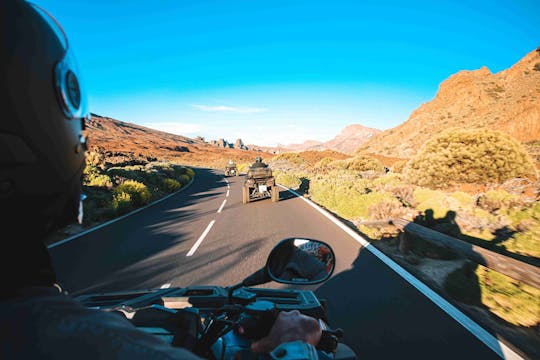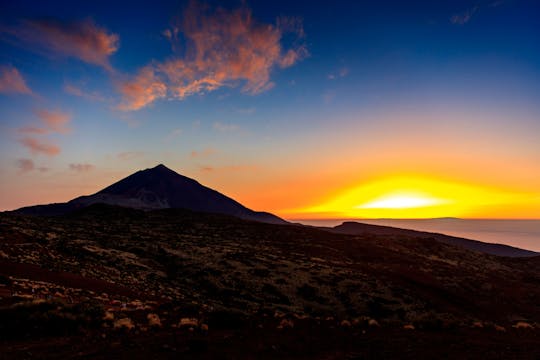
Teide tours and excursions

Experience Tenerife's beauty on a quad with the Sunset Quad Trip. Witness a spectacular sunset over Mount Teide. Book now for an unforgettable adventure.
en, es

Teide National Park sunset and stargazing tour
You'll drive into the heart of Tenerife's Teide National Park, hearing fascinating tales about its volcanic terrain. As the altitude rises and the air cools, you'll pause for a cosy hot chocolate. At golden hour, you'll head to a spot nestled in the forest to watch the sun paint the horizon. After dinner, it's time to unwind and get comfy on the terrace, ready for the stars. Powerful telescopes will reveal constellations, galaxies and distant planets. You'll also receive a starmap keepsake.
fr

Teide National Park sunset adventure by buggy
Experience the beauty of Tenerife on a guided buggy tour in Teide National Park. Capture panoramic views and savour a mesmerizing sunset. Book now.
en, it, fr, es, de

Teide National Park guided tour by buggy
Experience the thrill of a buggy tour through Teide National Park. Capture panoramic views and create unforgettable memories. Book now.
en, it, fr, es, de

Mount Teide Quad Trip in a Day
Enjoy an adventurous quad trip on Mount Teide and have fun with your friends and family.
en, es

Guided Cycling Tour to Mount Teide in Tenerife
Embark on a thrilling guided cycling tour in Tenerife. Conquer Mount El Teide and explore the island's natural beauty.
en, fr, es, nl

Teide by night from the south and west – Dutch tour
Tenerife's Mount Teide National Park boasts some of the most breathtaking scenery and views in all the archipelago. Crowned by the volcanic peak of Mount Teide, this natural wilderness takes on an otherworldly quality as the setting sun glazes its ridges and rocks in soft pinks, reds and purples.
nl

Teide by night from the south and west – German tour
Tenerife's Mount Teide National Park boasts some of the most breathtaking scenery and views in all the archipelago. Crowned by the volcanic peak of Mount Teide, this natural wilderness takes on an otherworldly quality as the setting sun glazes its ridges and rocks in soft pinks, reds and purples.
de

Teide by night from the south and west – French tour
Tenerife's Mount Teide National Park boasts some of the most breathtaking scenery and views in all the archipelago. Crowned by the volcanic peak of Mount Teide, this natural wilderness takes on an otherworldly quality as the setting sun glazes its ridges and rocks in soft pinks, reds and purples.
fr

Teide by night from the north – German tour
Experience an unforgettable evening of stargazing in the rugged landscapes of Tenerife's Las Cañadas del Teide National Park. On this romantic tour, you'll watch the sun go down and see the rocks of this otherworldly landscape turn shades of pink and red. Then, once darkness has fallen, an expert astronomer will point out different constellations.
de

Gear up for an exhilarating three-and-a-half-hour quad adventure in Tenerife, tailored for ultimate fun and excitement. This exclusive experience takes you on thrilling off-road trails with the choice of powerful 600cc quads. As you rev up your engines and set off, the raw beauty of Tenerife unfolds before you. The tour is designed to showcase the island's diverse terrains, from dusty paths to rocky roads, each providing a unique challenge and thrilling experience. Feel the adrenaline rush of manoeuvring your quad through narrow trails and steep inclines, all while surrounded by breathtaking natural landscapes. After an action-packed few hours, the tour winds down, but the excitement lingers as you head back. Share stories and relive moments of the journey as you view the footage captured on the GoPro. It's an ideal adventure that combines the thrill of speed with the beauty of nature, leaving you with lasting memories and stories to tell.

Teide National Park Hiking Tour
Mount Teide is the most popular attraction in Tenerife, and there's no better way to discover it than this hike. This 9km guided trek introduces you to the rare flora and fauna on the mountain as well as the lava flows. Once you've acclimatized to the altitude, you'll be met with knockout views over Tenerife and the other islands. This is a low/medium intensity hike, where you'll be walking for around three hours.
de, en
Top attractions in Tenerife
You might also like
The inside story
The Teide is a volcano located on the island of Tenerife in the Canary Islands (Spain). It is the country's highest peak, with an altitude of 3,718 meters above seal level and 7,500 meters above the ocean floor. It is the third-highest and bulkiest volcanic structure on the planet, after Mauna Loa and Mauna Kea in Hawaii.
During the European expansion, Teide's towering altitude explained why it was considered as the highest mountain in the world, since the Spanish, Portuguese and British sailors used it as a beacon during their navigation through the Atlantic Ocean to the South.


















